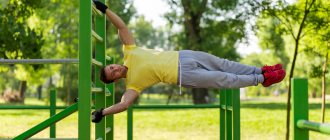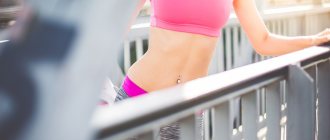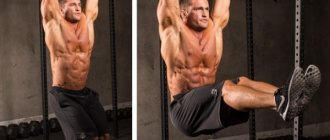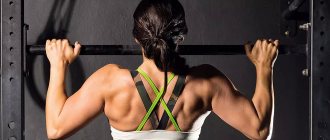Pull-ups are one of the most difficult exercises for beginners. Unlike squats or push-ups, not everyone can do a pull-up the first time. Many don't even know where to start.
Pull-ups are suitable for many people: men, women, teenagers and even children. You can exercise both at home and in the gym, and even on the street.
It is precisely because of its complexity that many teaching schemes for this exercise have been invented. They depend on the general physical preparation of the beginner and personal skills. Some will have to start from the very basics, while others will only need to improve the already developed technique. The main thing is to determine your level correctly.
The benefits of exercising on the horizontal bar
Everyone primarily associates the horizontal bar with pull-ups. Although this trainer has several uses. Even the smallest children can practice on it, performing a regular hang with a direct grip.
This activity relieves stress on the spine and forms correct posture. Hanging on a horizontal bar is necessary for the prevention and treatment of spinal curvatures.
- The most popular exercise - pull-ups strengthens the muscles of the back, shoulder and arms. They are loaded by the body's own weight when it is lifted. Strengthening the back muscle corset helps maintain a straight posture and greater endurance during physical activity.
- More complex complexes, such as inversion lifts, are performed by experienced athletes. They help to more actively develop the muscles of the arms and shoulder area, receiving greater load. Such complexes require not only high power expenditures, but also high concentration, which contributes to its further improvement.
- In addition to the back and arms, the abdominal muscles work while doing pull-ups on the horizontal bar. It tenses to increase the effort, thereby forming a beautiful slender stomach and sides.
Where to begin?
Methodology for starting to do pull-ups on the horizontal bar:
- You need to start by determining your level of physical fitness and previously acquired skills. You can start exercising both at home and in the gym.
- Most often, the question of training is asked by beginners who absolutely do not know how to perform this exercise. Therefore, it is worth considering the learning process from the initial level. At this stage, you need to prepare your body for a certain type of physical activity, in this case, doing pull-ups on the horizontal bar.
- To make the effort to lift the body to the bar, it is necessary to strengthen the muscles involved in this process. This will make learning go much faster. The easiest way to do this is by practicing push-ups. During them, similar muscle groups work, but it is much easier to perform. This way your shoulders and back will be trained.
- The seated lat pull-down exercise will be more effective. It simulates the work of muscles during pull-ups as much as possible and allows you not only to train, but also to understand the processes occurring in the body during the exercise.
Pull-ups
General rules
1. Hold the bar firmly. Use a medium overhand grip: your hands grab the bar at shoulder level.
2. Avoid sudden movements or jerks. It’s better to do it once smoothly than three times with a jerk.
3. Each pull-up consists of 4 phases:
- Climbing (35% of the time)
- Fixation (15%)
- Descent (35%)
- Pause (15%)
3. When rising, your gaze should be directed upward to the sky or ceiling. The chin is slightly raised. It's like you're pulling yourself up to the bar with your chest.
4. At the top point, the chin should be above the bar.
5. Avoid slow lifting and sudden lowering. When lowering, you should, just as when lifting, use your muscles and not give in to the force of gravity. Lowering and rising should be the same in speed and duration.
6. Exhale - while lifting and fixing over the bar, inhale - during descent and pause.
7. Ideally, lifting is done without swinging or using the legs. At the initial level, you can close your eyes to this point.
Scheme of pull-ups on the horizontal bar from scratch
0. To start, simply hang from the bar.
Bend your back, look up at the bar and the sky (ceiling). Feel your body in this position.
1. First day
Our beginner pull-up program starts with simulating pull-ups.
Grabbing the bar, try to lift your body a little, pause a little and lower yourself down. The lowering is equal in time to the ascent and occurs smoothly. The essence of the simulation is to provide an opportunity to correctly perform a minimal pull-up without concentrating on achieving the goal. We monitor breathing, body position, direction of gaze and execution technique.
2. First week
During the first week, our pull-up routine from scratch involves the use of a chair or the assistance of a partner.
We do full pull-ups, but with partial weight. For this purpose we use, for example, a stool, chair or any other elevation. The point is that part of the weight falls on the auxiliary object. To do this, you need to bend your legs at the knees and rest on an auxiliary object with your fingers or lifting your legs. The same function can be performed by a partner who will hold the legs at the shin or ankle.
As part of this stage of the program for beginners on pull-ups on the horizontal bar, we train daily or every other day. We perform 5-8 repetitions in 3 approaches.
3. Second week
Our zero bar pull up program in week two focuses on half pull ups or learning how to lower properly.
The half pull-up is also known as the negative pull-up. We can call it negative because Pull-ups like this don’t happen: we train not to drop sharply.
Holding the bar with our hands and pushing off the ground with our feet, we assume a position as if we had pulled ourselves up. We fixate: the chin is above the bar, the gaze is directed upward, the chest almost touches the bar. Then we lower ourselves smoothly.
We perform 5-8 negative pull-ups in 3 approaches.
4. Third week
In the third week of the pull-up scheme on the horizontal bar from scratch, we alternate exercises with the help of an auxiliary object or a partner and a negative version. If pull-ups are easy, increase the number of repetitions to 15-20.
It shouldn't be easy. It must be a load that can be overcome with effort.
The more perfect you are at doing light pull-ups in week three, the more successful you will be at doing full pull-ups.
5. Fourth week. Full pull-ups.
The previous three weeks of the beginner's pull-up program were necessary for the body to get used to physical activity and “understand” in which direction it needs to adjust. For a person who starts pull-ups on the horizontal bar from scratch, the issue of physiological adjustment is extremely important. After all, instead of sitting, you are going to build muscle mass. For our body, this is a completely different way of working.
Follow the general rules for pull-ups that we gave above.
Alternate between forward and reverse grips every day. Don't do them together in the same workout.
Start with the maximum number of pull-ups you can do. 3 pull-ups is very good. Do 3 approaches. It's okay if on the third approach you only do 1 pull-up. As soon as the number of repetitions in the first and last set is equal, add 1 extra repetition. Continuing the program from zero pull-ups on the horizontal bar, over time your muscles will get stronger, and the number of repetitions will increase to 5, 10, 15, 20.
How to learn to do pull-ups?
- In order to learn this exercise, you need to choose the most suitable technique for yourself. Exercises should gradually become more difficult as you get used to them. Continuity and systematicity of classes is important. As soon as you manage to pull yourself up for the first time on your own, you must definitely consolidate the acquired skill.
- Along with performing the exercises, it is important to learn the correct grip, simple hanging on the horizontal bar and precise execution technique.
- At first it will be difficult to do more than 1-2 lifts at a time. Therefore, after them, you need to continue to work on the established program, complicating it and without stopping trying to lift the body.
- Over time, full pull-ups will replace simple preparatory exercises, and all that remains is to increase the number of exercises and approaches. With the onset of this moment, you need to carefully monitor the technique and constantly practice it.
In addition to exercise machines, you need to stretch your back muscles to better feel their work. It is performed before training as a warm-up. During training, you should alternate approaches to block pulls and direct pull-ups using any initial technique.
Features of the exercise
There are many programs on the Internet on how to learn how to do 30 pull-ups in 7-30 weeks or 1-2 months, but it will be difficult to achieve this result by following only one system. After all, it is important to find out all the features of this exercise in order to fully perform it.
Pull-ups have the following advantages:
- During exercise, many muscle tissues are trained simultaneously, so pull-ups are often used to grow muscles, especially the back, abs and arms;
- By performing 30 pull-ups daily, you can protect your spine from various diseases, such as osteochondrosis or scoliosis, and you can achieve this figure in a maximum of 30 weeks.
- The pull-up system on the horizontal bar is suitable for any person and it is enough to install a regular bar in the house or go out into the yard, where it is most often found.
Focusing on the advantages that the horizontal bar training system has, we can conclude that the exercise is extremely beneficial for health. Before standing under the crossbar, experts advise you to familiarize yourself with the following tips:
- The pull-up scheme for muscle growth should be proven and guaranteed to produce results in 7-30 weeks, and the first successes will be noticeable within 30 days;
- Typically, all beginner pull-up training programs start with pull-ups and push-ups to strengthen the muscles;
- If you want to build muscle, then pull yourself up slowly and lower yourself quickly. You should always perform the exercise in this rhythm. If you do the ascent and descent quickly, the effect will be on the ligaments, joints and tendons. They will become more flexible;
- Achieving an increase in the number of repetitions of the exercise is not easy and for this you should increase the level of endurance and use different types of grips;
- When you can do pull-ups on the horizontal bar more than 30 times in 30 weeks, then you will need a table with a training program for pull-ups on the horizontal bar, since the desire for records can damage the health of beginners;
- If a person feels unwell, then no training should be carried out until recovery;
- During classes, you can turn on your favorite tunes so that the workout routine on the horizontal bar doesn’t seem so boring;
- Pull-up schemes on the horizontal bar work well for muscle growth and increasing endurance for people up to 45-50 years old, as can be seen from their photos, but in other cases the exercise may not give quick results;
- During the exercise, your head should be above the horizontal bar, and your chest should touch it. If you do pull-ups incorrectly, then there will be no effect from such training.
The right technique for a beginner from scratch
For beginners, there are several ways to start training:
Blocks
Blocks and reverse pull-ups help to train at the initial stage, when all skills are reduced to zero.
In these exercises, the athlete pushes off from a support and, bending his arms at the elbow to an angle of 45 or 90 degrees, fixes his position on the horizontal bar.
You need to hold this position for as long as possible, but at least 10 seconds in each position.
Reverse pull-ups
The reverse pull-up exercise can be a full-fledged training complex. It consists of a group of different blocks.
Starting position – elbow angle 45 degrees. After hanging in it for the set time, the athlete smoothly extends his arms to a right angle and is again fixed for a while, after which the angle increases to 120 degrees.
During exercise, the strength will gradually increase, and you can, having lowered yourself to the highest bend angle, try to rise, also fixing the blocks. First 90, then at the top point - 45 degrees. The final stage is the transition from short bends up to a certain block to a full pull-up without stopping.
Pushing off with one leg from the support
Pushing off with one leg from the support is a less effective method. It is used rather as a complement to other techniques. You can push to fix the block or start training short rises. In this method, a stool or step is used for support, and when exercising in a gym, it can be a wall bars.
Pull-ups with harness
In the latter case, a regular medical tourniquet or elastic band is used. At one end it is tied to the crossbar, and at the other end a loop is made under the buttocks.
She adjusts herself so that the tourniquet is pulled back, but at the same time provides a little support for the push. This method of initial training is suitable for those who already have slightly developed back muscles.
You can move on to them from the initial stages with gradual intensification of training. This exercise will be the last one before moving on to pure pull-ups, without any assistance.
When performing any exercises on the horizontal bar, you must not jump off it. This will create a shock load on the knee joints, which will lead to further damage. Incorrect standing on your feet when jumping can result in a dislocation of the knee joint or ankle.
Also, you should not make sharp jerks upward, trying to bend your elbows and suddenly throw your body from the top point of the lift. Such actions can damage muscle tissue and ligaments. The most common injuries on the horizontal bar are sprains and tears.
Description of the exercise
Pull-ups exist both as a separate exercise, which many people like to do on the horizontal bar at home, and it is often included in the training complex of experienced athletes.
What muscles work
When performing this exercise on the horizontal bar, the pectoral muscles, biceps, shoulder muscles, latissimus dorsi and forearm muscles are involved.
Exercising helps get rid of protruding belly and helps develop sculpted six-pack abs. It is worth considering that ordinary exercises will not achieve the desired result, and before performing training you need to familiarize yourself with the different types of grip.
Types
Pull-ups are divided into the following types:
- Classic. The athlete’s palms should clasp the bar from above, with their hands slightly wider than shoulder width. Raising the body in this way will not be difficult and therefore this training exercise can be performed even by a beginner in the pull-up system.
- Neutral. In order to perform a body lift, the athlete will need special bars, which will have to be located at a distance of 30-40 centimeters from each other. This type of pull-up also has another name - parallel. Performing this technique will allow you to work out the latissimus dorsi muscles, and especially their lower sections. The lifting of the body must be done to failure.
- Reverse. Before starting this technique, the athlete will need to turn his palms towards the body before grasping the bar. This will allow you to grab the crossbar from below. The distance of the hands is slightly less than the width of the athlete’s shoulders. The use of this type of pull-up will help to work out the muscle groups that are located in the chest area.
Difficulties for beginners
Beginning athletes face difficulties on the way to performing pull-ups correctly.
Their reasons are:
- Excess weight. Excess weight not only creates additional stress, but also partially hinders the functioning of the joints. Having this negative factor and not having played sports before, you should refuse to do pull-ups. This exercise requires good physical fitness. Therefore, you will have to first go on a diet and perform easier complexes that promote weight loss.
- Physical weakness. Even after normalizing your weight, you cannot immediately start doing lifts on the bar. To do this, you need to gain good physical health, develop muscles and tone them. Not only muscle strength must be developed, but also their endurance. It accumulates through constant repetitions of initial techniques, with a gradual increase in the number of lifts.
- Weak accessory muscles. Accessory muscles are intensively involved in lifting the body. Their strength will influence the quality and effectiveness of the workout. Therefore, when preparing for training, you need to pay attention not only to pumping up the muscles of the back, shoulders and arms, but also to the physical preparation of the body as a whole.
- Unpracticed or incorrect execution technique. Incorrect technique will interfere with learning. The exercise will be much more difficult to perform or, on the contrary, easier, but it will not have the correct effect on the muscles. In addition, violation of technique leads to accidental injuries, sprains and ligament tears.
What muscles are used when doing a pull-up?
During pull-ups on the horizontal bar, a large number of different muscle groups are involved. They are divided into main and auxiliary.
The main ones include:
- Forearms.
- Shoulders.
- Biceps.
- Triceps.
- Trapezoid.
- Latissimus dorsi muscles.
- Press.
They are responsible for efforts when bending and extending the arms, lifting the body and maintaining it in tension.
Accessory muscles:
- Radiation.
- Deltoid.
- Breasts.
They do not have a direct impact on the creation of movements performed when pulling up on the horizontal bar. But when they tense, they create a rigid frame for the body, which facilitates easier and more precise movements.
Ways to do pull-ups
By performing this exercise, various muscle groups are worked out. Loads well:
- dorsal backs;
- biceps;
- shoulder muscles;
- trapezoidal;
- paired round.
Muscles involved during a pull-up. They are marked with colors in the figure. Pull-ups allow you to work several muscle groups at the same time
There are several ways to perform the exercise - pull-ups, each of which distributes the load on the muscles differently. Let's look into this issue.
The main ones:
- If you do pull-ups with your hands in a medium straight grip, the following muscles are affected: the back, shoulders, and biceps. Hands in this case should be shoulder-width apart from each other, palms turned away from the face;
Correct technique is the key to the effectiveness of the exercise. Medium straight grip - excellent pumping of the muscles of the arms, back, shoulders
We also recommend studying this topic:
How can you do pull-ups on a horizontal bar? Main types and technique of execution
10294 0 0
- By doing pull-ups with a medium reverse grip, the athlete works the biceps, as well as the latissimus dorsi muscles. Hands should be positioned similarly to the previous option, but the palms are turned towards the face;
Performing pull-ups with a medium reverse grip. Correct technique is the key to good results
- wide grip to the chest. This embodiment affects the trapezius, as well as the paired circular muscles and the upper zone of the latissimus dorsi muscles;
Wide grip to the chest - technique for performing the exercise. If you follow all the subtleties, you can achieve the desired result.
- with a wide grip on the head. The best exercise for working the trapezius and paired teres muscles. In addition, the middle as well as the upper zone of the latissimus muscles are indirectly involved;
Performing pull-ups with a wide head grip. Excellent work of the back muscles
- A narrow and straight grip allows you to work the shoulder muscles, as well as the serratus muscles. In addition, the lower zone of the latissimus dorsi muscles is involved;
Pull-ups with a narrow straight grip. The closer the hands are to each other, the greater the load on the muscles
- narrow reverse grip. Such pull-ups force the biceps to work, as well as the lower zone of the latissimus muscles;
Pull-ups with a narrow reverse grip pump up the biceps. The exercise gives a good effect
- Performing the exercise with a neutral grip is aimed at working the brachialis and serratus muscles. In addition, the lower zone of the lats is involved in the work.
Neutral grip pull-ups. Correct technique and toned shoulder muscles
Important! In addition to the muscles involved, changing the grip width can change the load. The narrower it is, the larger it is.
Readers found these materials useful:
- Sports compression clothing CW-X - the choice of athletes
- Modern technologies in the production of medical clothing Incrediwear
Choosing workout clothes
Clothing for training must be comfortable, consisting of natural or special synthetic breathable material. The uniform should not hinder the athlete’s movements, rise up uncomfortably or dig into the body, distracting from training. These could be T-shirts or tank tops, sweatpants, shorts or leggings.
- Girls need to choose special sports underwear. It correctly supports the characteristics of the female figure during training and does not create additional discomfort due to the pleasant material, the absence of hard inserts and protruding seams.
- Shoes must be special sports shoes, chosen exactly in size. A small one will put pressure on and deform the leg, interfering with the correct technique for doing the exercises. A large one creates a risk of leg injury due to poor foot fixation.
- Socks must be worn under shoes. They should not be made of unpleasant synthetic material. A properly selected sock wicks away moisture well and does not interfere with foot ventilation, preventing the greenhouse effect.
All equipment is selected based on one main rule: performing exercises should be as comfortable as possible. Physical activity itself requires full concentration. Therefore, the athlete should not be distracted by irritating factors such as uncomfortable clothing.
Warm-up
- Warm-up before training begins with a warm-up. Running, jumping rope and any other active movements will raise body temperature and activate all muscles.
- During normal movements, the joints work in a moderate mode and sometimes stagnate. Active physical activities place a lot of stress on them, so you need to work every joint to “wake them up.” For this part of the warm-up, rotational movements of each node are performed.
- The exercises are performed starting from the upper body and gradually descending below. Before doing pull-ups, warm up your hands, elbows and shoulders especially carefully, as they take on most of the load.
- The warm-up ends with stretching. It increases the elasticity of muscles, allowing them to work much more efficiently and not hurt after training.
Particular attention should be paid to the muscles of the arms and back. The entire warm-up should take about 15 minutes. 5 minutes for each block of exercises.
On developing the ideal upper body
The latissimus dorsi is the main muscle worked during pull-ups. They are also the largest muscles in the back, so it is extremely important to develop them and keep them in shape.
Pull-ups work all the muscles in your back, including your shoulders, upper and middle back, as well as your arms and core.
The other exercises in this 30-day workout program will also help you get closer to your ideal upper body shape. Reverse-grip rows and pull-ups pump up the biceps, and arm swings build strong shoulders.
A strong, healthy back is essential for good posture. At the end of this 4 week course you will be slimmer, taller, stronger, fitter and more attractive.
These exercises help prevent shoulder injuries and get rid of neck pain, which most often occurs due to the sedentary lifestyle of modern people. They are also recommended to be included in various plans and training regimens, and even in yoga practices.
Regular grip pull-ups VS. reverse grip
People often wonder about the difference between these two types of pull-ups. The only difference is the execution technique, or rather the grip.
With a reverse grip, your hands are facing towards you, and with a regular grip, your hands on the bar are facing away from you. With a normal grip, your hands are wider than with a reverse grip.
Performing pull-ups with a reverse grip is a little easier because the biceps are involved in the work, which will help in lifting the body weight. With a normal grip, the emphasis is on the latissimus dorsi muscles.
Both variations are upper body muscle builders and are an important part of any strength training routine.
Exercises on simulators for quick results in pull-ups
There is also a special simulator for learning pull-ups. It's called a gravitron . It represents a platform for the athlete to position himself and a horizontal bar for pulling himself up.
A counterweight is attached to the crossbar, which simulates the force from lifting the body. By exercising on such a machine, you can adjust the load, moving to a new level.
In addition, it allows you to examine and understand in more detail the sequence of work of all muscle groups during pull-ups.
- Exercises on special simulators will develop muscles and prepare them for doing pull-ups.
- The best machines for training your upper body are the pull-down and rowing machines.
- They challenge your arms and back, building muscle mass and building endurance through long workouts.
- You need to train regularly at the preparatory stage, performing at least three sets of 10–15 repetitions 2–3 times a week.
Pull-up program on the horizontal bar in the form of a table
| Approach number/week | 1 | 2 | 3 | 4 |
| 1 | 4 | 5 | 7 | 9 |
| 2 | 3 | 4 | 6 | 8 |
| 3 | 3 | 4 | 6 | 9 |
| 4 | 3 | 5 | 7 | 9 |
As you can see from the table, you need to increase the load gradually, carefully, so as not to lead to injuries and overwork. After the first month of training, you need to increase the load 2-3 times.
Before you start training on the horizontal bar, you should learn the following rules that will help you avoid injuries and achieve excellent results.
- Before training, a short warm-up is necessary. 5-10 minutes of cardio will be quite enough, and this can be not only running, jumping or jumping rope, but also fast walking, cycling or something else that could thoroughly warm up the body and prepare it for strength training.
- In order to increase weight, you need to reconsider your diet; it should consist more of proteins. There should be a minimum of sweets. You need to slightly increase the number of calories consumed so that muscle mass does not dry out.
- Each workout should end with a little stretching, which helps the muscles recover faster after exercise, which also allows you to gain weight faster.
The rules are known, now let's start studying serious, professional sports programs.
Pull-up diagram on the horizontal bar
Today, the most popular scheme is considered to be 50 pull-ups on a horizontal bar. To find out which step of the program to start with, you need to pass a test that determines the level of sports training, according to which you can choose the most correct regime. The test is as follows: we do pull-ups on the bar as many times as possible, performing the exercises efficiently (without cheating or jerking). If the maximum number of pull-ups is 7, then the 7-8 program is suitable for you (we’ll talk about it in more detail a little later).
This program involves more rest than subsequent ones; this is the initial stage, starting from which you need to move towards perfection. Here it is important not to waste your energy reserves and willpower when you reach your goal.
Rest between sets should be at least two and no more than ten minutes. You need to eat five times a day, this is the only way the body can work out in the right quality. Having realized that this training cycle is easy to complete, we raise the bar for achievements, moving on to the next cycle 9-11 and so on.
The ultimate goal is to learn to do 50 pull-ups in one set. This skill, of course, is inextricably linked with an ideal appearance, which is what we strive for.
Training programs for different levels
Different levels of physical fitness require individual programs for muscle development and pull-up training. Physical condition depends on several factors. It is influenced by a person’s gender, age, build, and lifestyle.
Zero level
For those starting from scratch, it is important not to overdo it and not try to follow the tables offered in large quantities on the Internet. During the first training sessions, you need to understand the essence of the exercise and master the correct technique.
- The best way to do this is with a simulator , but in its absence you need to rise into the block, pushing off from the support, and slowly lower, observing the work of the muscles.
- To practice lifting, you need to use a tourniquet or the help of a trainer. Such exercises should be performed in several approaches with short rest intervals. 10 repetitions 3 times. These exercises should be given 2-3 workouts.
- In the second week of training, you need to pay attention to muscle development in order to move on to full exercise. To do this, each approach should alternate with lat pulldowns. This complex is performed the same 3 times for 10 repetitions.
- As soon as you begin to be able to lift yourself independently without additional support, you need to gradually increase them. The training volume remains the same. Preparatory exercises are gradually being replaced by ordinary ones.
For men
The male part of the population naturally has a more developed muscular frame and many can initially do 1-2 pull-ups. If you don’t even have such a skill, then you need to lift with a push from the support and slowly lower.
- In the first approach, lowering and lifting are performed with the block fixed at each point for 5–10 seconds, the remaining two are done smoothly, without stopping. Each set contains 10–15 repetitions.
- As soon as pull-ups become independent, you need to add exercises on simulators to increase endurance. Perform as many clean pull-ups as possible and move on to the machine. For example, do 2-3 pull-ups and perform 10 reps on a pulley row or rowing machine. The number of pull-ups for the entire workout should be at least 10 and gradually increase.
- After the exercise becomes easy to perform 10 times , training on training complexes can be eliminated or reduced to a minimum. Now you can focus on the number of lifts and approaches, working on the execution technique.
For girls
Girls most often have a weak muscle base, and pull-ups are not easy for them without difficulty and effort.
- Before you start the training itself for the first week, you need to prepare your body. To do this, perform lat pulldowns 10 times in three approaches. Each of them should alternate with an elliptical, treadmill or any other cardio machine.
- A simpler option is training on a special installation. The counterweight exercise machine is great for beginner girls. It immediately imitates pull-ups, while facilitating the moment of lifting the body. You need to do 10–15 lifts, 3 sets.
- In the second week, you can start doing pull-ups with a push from a support or with a tourniquet. You need to perform 10 repetitions 3 times. Strength training is reduced to one approach, and cardio is excluded or added at will as a warm-up and cool-down.
- In the third week, independent pull-ups should be increased and added until other exercises are completely replaced. It is much more difficult for girls to learn how to climb on the horizontal bar. Therefore, you can start switching to regular pull-ups not from the third, but from the fourth week.
For children
Children do not have sufficient physical fitness to perform such exercises, although they are more dexterous and learn quickly.
- Their preparatory stage will take longer - about three weeks. During this time, you need to perform push-ups from your knees, plank, hyperextension, press, hanging on the horizontal bar and monkey bars. Each exercise should be given up to 10 repetitions of 1 approach. Perform 2-3 workouts per week.
- In the third week, you can start learning pull-ups. To understand the principle of the exercise, children can do pull-ups not from a hanging position, but with their feet against the wall. This way he can understand the technique and try his hand at it.
- By the end of the month you should start doing regular pull-ups. Since a child, boy or girl, will most likely study not independently, but with an adult, the easiest way to learn is with help.
- The child needs to be lifted, holding him by the waist and lower back, not allowing him to lean heavily on his arms. Pull-ups should strain his arms at least a little and make him feel the weight of his own body. Gradually, assistance should be reduced until complete independence. Perform 1-2 sets of exercises each, no more than 10 times.
For full
- For overweight people, having excess weight will make it very difficult to perform lifts on the bar. Therefore, when drawing up a training program, you need to devote the first month to fat-burning training and diet, since without losing weight you cannot achieve a good result.
- As soon as the first weight loss is noticeable, you can gradually add sets of pull-ups with help. You need to start with 1 approach of 10 times, gradually increasing their number. You can begin constant independent pull-ups if you confidently perform at least 10 lifts.
Program for beginners
Many people cannot do even one pull-up if they have not exercised for a long time or their body weight is significantly higher than normal. In such a situation, the main thing is not to despair, because even record holders once could not do a single repetition of the exercise. Initially, the following tips are suitable for people who cannot do pull-ups:
- You can pull yourself up with a support under your feet or with a belay person, but it is advisable to lower yourself down slowly and on your own to pump up your arms;
- If necessary, you can resort to using special rubber bands;
- If you are just a little short of the desired rise, then you can make a jerk;
- On the street, you can choose a low bar to have support under your feet and perform the exercise from this position.
You need to exercise using these tips for 1-2 months to strengthen your muscles. Next, you can switch to another system of pull-ups to build muscle on the horizontal bar and look at the graph for beginners below. Table of pull-ups on the horizontal bar:
Even an inexperienced athlete, following this table of training on the horizontal bar, will be able to do over 25 repetitions per day in just 2 weeks. After achieving the required goal, you should stay on this scheme for about a month to strengthen the result, and then you can move on to more advanced programs. In total it will take approximately 7 weeks to obtain the desired result.
Training program on the horizontal bar
For those who have learned to do pull-ups well and many times, special programs are drawn up to develop this skill. To do this, set a goal, for example, to do 50 pull-ups. First, determine the number of pull-ups you are performing at the moment.
On average this is 5–10 times. Then the training program will begin with 5-6 lifts. It is calculated by day.
The numbers indicate the number of pull-ups in one approach:
- First workout: 4, 6, 5, 5, 6. Total 26 times.
- Second workout: 4, 7, 5, 6, 7. Total 29 times.
- Third workout: 5, 8, 5, 7, 8. A total of 32 times.
- Fourth workout: 6, 9, 6, 7, 9. A total of 37 times.
- Fifth workout: 6, 10, 8, 8, 10. A total of 42 times.
- Sixth workout: 8, 12, 8, 10, 12. A total of 50 times.
Rest between sets should be 1-2 minutes, and between workouts 1 day. After the first three workouts, a break of 2 days is taken.
Pull-up chart for beginners
Advanced training systems
There are other tables, for example, a 30-week pull-up program. This training is aimed at more experienced and trained athletes. It allows you to do 82 repetitions of the exercise per day. In the future, the result can be developed, and the number of lifts will exceed a hundred. There will be 3-4 workouts per week of 5 approaches. You need to rest no more than 90-120 seconds between them. Every week the number of repetitions will increase and by the end of the course will reach the recommended maximum. You can look at the pull-up increase chart below:
There is an extended version of the training program that is suitable for strong people who play sports professionally. The pull-up increase chart for the 52 week course is below:
A course of 50 pull-ups can achieve no less impressive results. It can be performed by people who are able to repeat the exercise 5 times in 1 approach. This program will take 2-3 weeks. During this time, you can increase the size of muscle tissue and increase endurance. You will need to train 3-4 times a week, that is, every other day. Each training includes 6 approaches, during which you will ultimately complete 50 repetitions of the exercise. The initial number of pull-ups on a hike does not exceed 5, but gradually it will need to be increased to 8-10. If this does not seem enough, then the indicators can be doubled over time.
To pump more muscles and get a better effect, experts advise combining grips.
For example, do 5 pull-ups with your arms spread wide, then narrow them 5 times, etc. From time to time you can switch to neutral pull-ups on the horizontal bar and change the direct grip to the reverse one. The result will be noticeable within 2-3 weeks, but if difficulties arise during training, it is advisable to have someone as a backup. However, you need to hold not by the lower limbs, but by the shoulder blades, so that in case of a fall the athlete can group himself and not injure another person.










